by Tom Gaylord
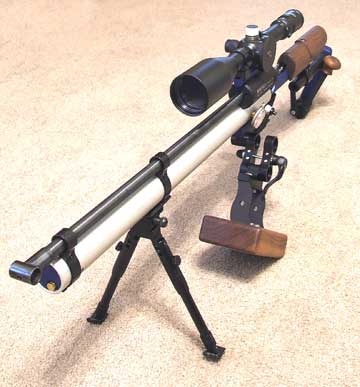
Not what you might expect in a rifle, the USFT requires a little orientation.
B.B. Pelletier invited me to report on the USFT rifle because several readers have expressed an interest in the gun. The first time I saw one was when Steve Schulz brought his new rifle out to the DIFTA field target club, where I used to shoot. Steve’s gun wasn’t actually a USFT; it was a hand-made rifle called a Simple Simon made by Larry Durham. I was intrigued that Steve’s rifle got 55 shots with Beeman Kodiaks at just under 900 f.p.s. on a fill of just 1,800 psi! That was less air than any other precharged rifle had remaining when all the useful shots were finished. The rest of us were filling to 3,000 and Steve only had to go to 1,800 to get the same results.
Steve is one of the finest field target shots in the world, so the fact that he did well with his new rifle was less impressive. He’s the kind of shooter who can outshoot most of us with our own rifles, so high scores from him are not exactly news. That clouded my observation of the rifle until I got one of my own. Having played with one, I now I understand that the ergonomics far surpass any other competition air rifle.
The appearance of the USFT commands attention. It doesn’t look like anything you have ever seen. In this report I will walk you around the features that set the gun apart. For, it is the egonomics, not the fact that it runs on low pressure, that makes this air rifle the star that it is.
One warning. This airgun is made for the sole purpose of winning field target matches. It isn’t a plinker; it isn’t a hunter and it certainly isn’t a general-purpose air rifle. If you want one of these, want it for the right reasons, because you’re going to have to invest some of yourself in the relationship. I think you will understand as I explain the features.
The USFT is a production gun with a lot of hand work still applied during the assembly process. Tim McMurray makes it, and he told me that 113 rifles have been sold thus far. He’s looking at starting the second run soon. The rifle just took four of the top five places at the U.S. national field target matches, so the demand for them is very heated.
The valve
The valve is the heart of this rifle. It’s an impact-type that is completely different from any you have seen before. It has a low-mass hammer that strikes an ultra-thin valve stem to open the valve against a very weak return spring. The air transfer port is elongated and runs inside what I must call the bolt, for want of a better term.
To achieve the velocity my rifle gets (an average of 938 f.p.s. for Beeman Kodiaks and JSB Exacts, alike), a lot of air must flow through the barrel. That means the valve must be open for a longer period of time, because the air pressure in the reservoir is lower than that of a conventional PCP. A long barrel allows the push on the pellet to be sustained longer, so, just like that 4,000-lb. Cadillac that is so difficult to get rolling when one person pushes it, eventually the pusher builds momentum and can push the car as fast as he can run.
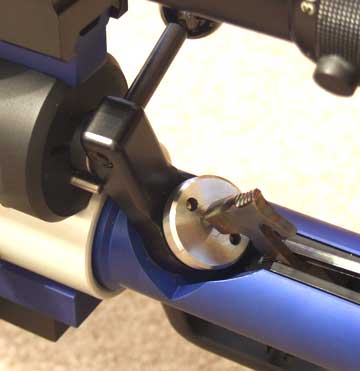
The bolt is closed.
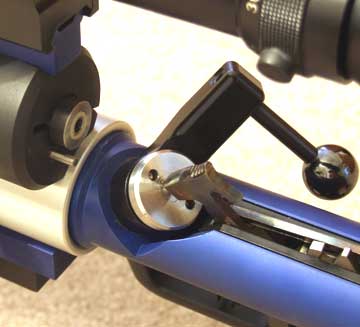
The bolt is open for loading.
This valve was designed to be repaired by the user! It comes apart easily because both the designer (Durham) and the manufacturer (McMurray) wanted it that way. You can even purchase the tools and parts to rebuild your valve. I did, even though I feel confident that the low operating pressure of the gun means I may never have to touch it. Airgunners will understand how I feel.
Loading
To load, the bolt is rotated to the right, exposing the breech of the 25″ Weihrauch barrel. There is more room for loading pellets than anything other than a breakbarrel. The bolt glides on bearings and seals that seem bank-vault solid. There are no detents to alert you to when things are in place – they just are, and you soon learn to accept it.
Cocking and firing
Cocking the low-mass hammer is impressively easy. Just pull it back until you hear the sear click. It doesn’t take more than a few pounds of effort. If you want to dry-fire the rifle, just cock the sear without moving the hammer. The trigger-pull feels the same either way and no air will be lost that way. Not that field target shooters dry-fire their rifles that often, but you will want to impress your friends with that trigger, whose pull is less than the 8-oz. minimum of my gauge. I estimate a pull of one or two ounces at most.
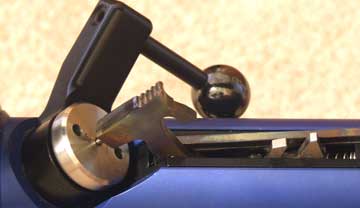
Hammer is down on valve stem.
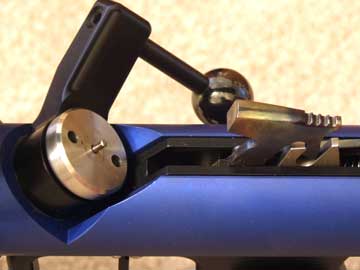
Hammer is cocked.
Filling
The fill nipple is a male Foster hydraulic fitting located on the left side of the receiver. It comes with a female cap, protected by a vinyl cover so no dirt gets inside the gun between fills. McMurray located the fill nipple on the rifle’s left rear to keep shooters away from the muzzle for increased safety. I like the Foster quick-disconnects because they are easily obtainable anywhere, and three of my PCPs now have them.
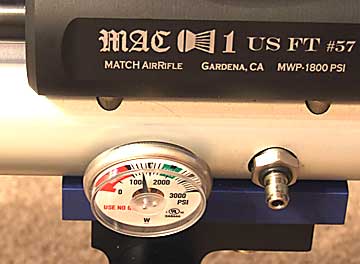
Fill nipple is a male Foster. Large gauge is easy to read.
While Steve’s rifle filled to 1,800 psi, mine needs only 1,650 – further lightening the burden on anyone who fills with a hand pump. I don’t yet know how many shots I will get, but the useful shots are within a string that doesn’t exceed 11 f.p.s. so far. Knowing that PCPs do change as they break in, I will watch the gun’s performance during the first year. Mine comes off the power curve below 1,300 psi on the rifle’s built-in pressure gauge – a gauge, by the way, that is large enough to be reasonably accurate.
In the next report, I’ll try to finish the features and get on with shooting.
Hello,
is the trigger fully adjustable?
Markus
Markus,
I passed your question along to Tom and he will answer it in the next installment. The trigger is single-stage as it came from Mac-!, and he doesn’t think there is an overtravel screw, but he has asked Tim at Mac-1 for clarification.
B.B.
Thank you for covering the details about the bolt, valve, hammer, springs, barrel length, etc. thoroughly (and with pictures)!
.22 multi-shot
Thanks! I will stay tuned for the next report! The pictures here are much better than mac-1s. The anodizing is great!
-sumo
Sumo,
I forgot to mention the overall beauty of this rifle. There is so much to look at that you get lost in the details, but yes, the finish is inpeccable.
Tom Gaylord
Marcus,
I heard from Tim. This is a two-stage trigger, but it is very difficult to feel the second stage. I adjusted it for two stages, then decided I couldn’t get used to it and went back to a single stage. The trigger blade is adjustable fore and aft. There are no other adjustments.
Tom Gaylord
Would this be a “long tom”? It’s got the looks, but is this one, or any air rifles (bullet or pellet) that are made for the long shots comparable to an “average” firearm. 500 yards tops maybe (target rifles: I wouldn’t use an air rifle for long shot hunting unless it’s big bore that’s proven capable of such). JP
Tom Gaylord,
did you get your bipod from mac-1? What comes stander and what is on your gun that is an optional accessory? Do they sell nikko scopes and mounts for the gun? Thanks for all your help!
-sumo
Hi BB,
I just wanted to say thanks for posting those big bore links the other day for me.
Cheers,
Steve
JP,
I don’t understand what you are asking. Can you plerase restate your question?
B.B.
sumo,
The bipod is from Leapers. I haven’t covered it yet. Many shooters use a Harris bipod. It attaches to a sling swivel stud.
Tom Gaylord
What I’m thinking of is an air rifle capable of firing out to 500 yards/meters accuratly, since that’s the type of range we used in the USMC with the M-16. Given the distance, and the speeds probably required, it might have to fire a bullet supersonic I would guess. Is there any such air rifle, big or small bore, and would they be any use other than target sniping? JP
JP,
No diabolo pellet can shoot that far – accurately or not. 500 yards is about the max diatance a diabolo pellet will travel if the bore of the gun is elevated 30 degrees to the horizon for max travel.
Big bore airguns that shoot bullets can shoot that far, and some are reasonably accurate. Reasonable means they can hit a water pail often.
B.B.
BB,
How easy is it to shoot the USFT in standing offhand positions?
I know the name implies it is dedicated to Field Target but there shots that must be taken standing.
Great post and I really look forward to coming updates on the USFT. More pictures please…thanks.
David
David,
I know that Tom Gaylord is running part 2 of his report on the USFT on Monday. I relayed your question and he plans on addressing it then.
B.B.
Help me mister wizard! I am the proud owner of Mac Hunter SN 54. What bipod arrangement are you using inthe above photos? tlowman-at-sbcglobal.net
Proud Owner,
That is a Leapers bipod. It was identified in Part 2 of the 3-part report:
/product/utg-universal-bipod-telescoping-legs-picatinny-sling-swivel-mount?a=882
/blog/2007/8/usft-rifle-part-3/
B.B.
What exatcly makes the rifle so efficient? Its 45°-tilted valve arrangement?
Mel,
The rifle is efficient because of a very light hammer spring and weight. It only opens the valve as much as needed and no more. You can only do this with lower air pressure or with an electronically controlled valve.
B.B.
Sir,
I always read most blog about custom made air rifles but most of them are PCPs.
My question is,
Why they don’t make a custom made spring piston air rifle that eliminates recoil by mimicking those designs used in artillery?
Chris,
They do, or at least “they” did. It was called the Whiscombe and I have written about it many times.
B.B.
Sir,
thank you for the article about whiscombe. my cousin offered me financial assistance to build another spring piston air rifle.although the plans looked like a DSR-1 sniper rifle.
I’ll read more about the Whiscombe.